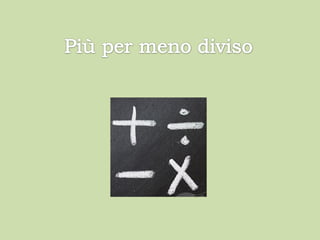
Più per meno diviso
- 4. 1800 BC 800 BC 300 BC 100 BC 100 300 500 700 900 1900 BC Papiro di Rhind 1800 BC Strassburg tablet 800 BC Shulba Sutras 300 BC Euclide 100 Erone 200 Diofanto 500 Aryabhata 600 Brahmagupta 800 Al-Khwarizmi
- 5. Al-Kitab al-mukhtasar fi hisab al-jabr w’al-muqabalah Muhammad ibn Mūsà al-Khuwārizmī al-muqabalah, rimuovere quantità uguali da entrambi i lati di un’equazione al-jabr, eliminare le quantità negative da un’equazione spostandole da un membro all’altro: la «restaurazione», l’algebra. (al-Khuwārizmī → algoritmo) «En esto fueron razonando los dos hasta que llegaron a un pueblo donde fue ventura hallar un algebrista con quien se curò el Sansone desgraciado». Miguel de Cervantes, El ingenioso hidalgo don Quijote de la Mancha, tomo secondo, capitolo dodici.
- 6. Liber abaci (1202) Leonardo di Pisa detto anche Leonardo Fibonacci (figlio di Bonaccio) per la prima volta in Europa vengono introdotte le nove cifre, che Fibonacci definisce "indiane", e il segno 0 che in latino è chiamato zephirus, adattamento dell'arabo sifr, ripreso a sua volta dal termine indiano śūnya che significa "vuoto". Zephirus in veneziano divenne zevero e infine comparve l'italiano "zero“. La quantità sconosciuta, l’incognita, vien e chiamata res (cosa)
- 8. L’Europa alla fine del ‘400
- 11. Nicolas Chuquet, Triparty en la science des nombres (1484) Chuquet chiama l'incognita "numero primo" e dunque la regola dei primi è, di fatto, la regola dell'incognita Règle des premiers
- 13. co per cosa (l’incognita) ce per censo (il quadrato della cosa) cu per cubus (il cubo della cosa) cece (il quadrato del quadrato della cosa) L’arte della cosa L’algebra diventa l’arte, o regula della cosa (regula cosae), ars rei et census, ars cossica o cossa. Luca Pacioli, Summa de Arithmetica, Geometria, Proportioni e Proportionalità (1494)
- 16. la parola plus non arriva prima del XV secolo mentre la parola minus ad indicare la differenza la si trova già in Fibonacci (1202) et
- 17. Y ... ÷ _
- 18. Johannes Widmann Arithmetic or Behende und hüpsche Rechenung auff allen Kauffmanschafft (l’aritmetica mercantile ovvero il calcolo agile e pulito per tutti i mestieri, 1489) come segni di operazione: Giel Van der Hoecke Een sonderlinghe boeck in dye edel conste Arithmetica (lo straordinario libro della nobile arte aritmetica, 1514); Heinrich Schreyber (Henricus Grammateus) Ayn new Kunstlich Buech (il libro della nuova arte, 1518).
- 19. Nei libri sacri della matematica l’uguaglianza era espressa per lo più a parole, in latino (aequales per esempio) o in tedesco (gleich) o sincopata Regiomontanus aveva introdotto un segno semplicissimo, una linea orizzontale ,– , gradita persino al principe della sincope Pacioli, che l’aveva fatta sua. nel 1521 Francesco Ghaligai nella sua Pratica d'arithmetica afferma che una linea non basta, che potrà di certo servire a separare i fattori ma niente di più. Se vogliamo affermare che due fattori sono uguali dobbiamo essere decisi, di linee ce ne vogliono tre, così: ---.
- 21. Gemowelines «… per evitare la tediosa ripetizione di queste parole: “è uguale a”, metterò (come uso spesso nel lavoro) una coppia di parallele (o righe gemelle) di pari lunghezza (così =) perché non ci sono due cose che possono essere più uguali»
- 22. C C 1579 , Leonard and Thomas Digges (father and son) 1637, Descartes 1644 , Pierre Hérigone 1668, René-François de Sluse | || || *ǽ stilizzato (da aequalis) o forse un simbolo astronomico] 1644 , Leibnitz (solo nella corrispondenza) ||
- 23. Thomas Harriot Artes analyticae Praxis 1631 John Wallis Mathesis universalis 1657
- 24. * .
- 25. Aritmeticae in numeris et speciebus instituio: quae tum logisticae, tum analiticae, atque adeo totius matematicae quasi clavis est (il metodo per calcolare in numeri e lettere: che fu la prima chiave per l'aritmetica, poi dell'analisi e ora di tutta la matematica, 1631)
- 26. in un appendice dell’edizione tradotta in inglese da Edward Wright e pubblicata nel 1618, appare la X come segno di moltiplicazione. La croce di Oughtred è però un’altra cosa, una crocetta posta in alto tra due fattori, così: × John Wallis nell’Arithmetica infinitorum (1655) usa indifferentemente la X e la × ma a un certo punto si pente e lo scrive in una lettera inviata nel settembre del 1669 al direttore della Biblioteca della Royal Society, John Collins Johann Rahn, che pubblica nel 1659 in Svizzera la Teutsche Algebra, al segno della croce preferisce quello dell’asterisco *,
- 27. Leibniz a Jacob Bernoulli (29 settembre 1698): «Non mi piace × come simbolo per la moltiplicazione, è facile confonderlo con la x; [....] spesso metto semplicemente in relazione due quantità con un punto interposto e indico la moltiplicazione con ZC∙LM». http://blog.stephenwolfram.com/2013/05/dropping-in-on-gottfried-leibniz/
- 28. «Arrivò a Albury (per 100 sterline all'anno) dopo essere stato in carica a Shalford i cinque anni precedenti. Egli è ben noto per il suo libro Clavis Mathematicae. È stato detto che fosse un predicatore scadente; il motivo è da attribuire al fatto che non ha mai studiato, ma ha piegato tutti i suoi pensieri alla matematica; quando però fu in pericolo di sequestro da parte di un fautore della monarchia, si immerse nello studio della divinità e predicò mirabilmente bene, anche in tarda età»
- 29. :
- 31. John Pell (1611 – 1685) Johann Rahn(Rhonius) (1622 – 1676)
- 32. Teutsche Algebra, oder algebraische Rechenkunst, zusamt ihrem Gebrauch (1659)
- 35. Il primo registro pubblico di contributi originali alla conoscenza Philosophical Transactions of the Royal Society Londra, 6 March 1665 Henry Oldenburg (Heinrich) (c. 1619 – 5 September 1677)
